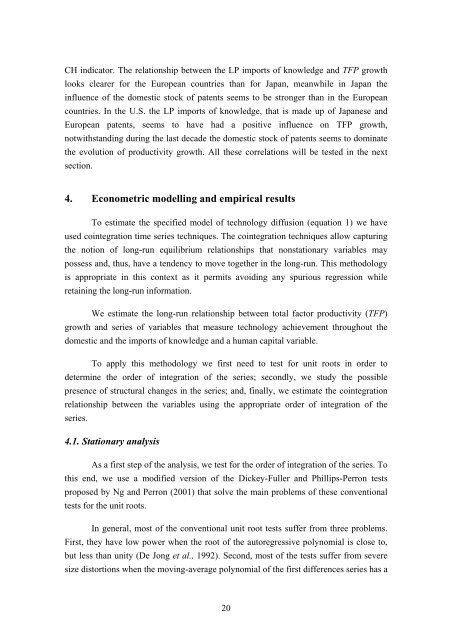You also want an ePaper? Increase the reach of your titles
YUMPU automatically turns print PDFs into web optimized ePapers that Google loves.
CH indicator. The relationship between the LP imports of knowledge and TFP growth<br />
looks clearer for the European countries than for Japan, meanwhile in Japan the<br />
influence of the domestic stock of patents seems to be stronger than in the European<br />
countries. In the U.S. the LP imports of knowledge, that is made up of Japanese and<br />
European patents, seems to have had a positive influence on TFP growth,<br />
notwithstanding during the last decade the domestic stock of patents seems to dominate<br />
the evolution of productivity growth. All these correlations will be tested in the next<br />
section.<br />
4. Econometric modelling and empirical results<br />
To estimate the specified model of technology diffusion (equation 1) we have<br />
used cointegration time series techniques. The cointegration techniques allow capturing<br />
the notion of long-run equilibrium relationships that nonstationary variables may<br />
possess and, thus, have a tendency to move together in the long-run. This methodology<br />
is appropriate in this context as it permits avoiding any spurious regression while<br />
retaining the long-run information.<br />
We estimate the long-run relationship between total factor productivity (TFP)<br />
growth and series of variables that measure technology achievement throughout the<br />
domestic and the imports of knowledge and a human capital variable.<br />
To apply this methodology we first need to test for unit roots in order to<br />
determine the order of integration of the series; secondly, we study the possible<br />
presence of structural changes in the series; and, finally, we estimate the cointegration<br />
relationship between the variables using the appropriate order of integration of the<br />
series.<br />
4.1. Stationary analysis<br />
As a first step of the analysis, we test for the order of integration of the series. To<br />
this end, we use a modified version of the Dickey-Fuller and Phillips-Perron tests<br />
proposed by Ng and Perron (2001) that solve the main problems of these conventional<br />
tests for the unit roots.<br />
In general, most of the conventional unit root tests suffer from three problems.<br />
First, they have low power when the root of the autoregressive polynomial is close to,<br />
but less than unity (De Jong et al., 1992). Second, most of the tests suffer from severe<br />
size distortions when the moving-average polynomial of the first differences series has a<br />
20

















